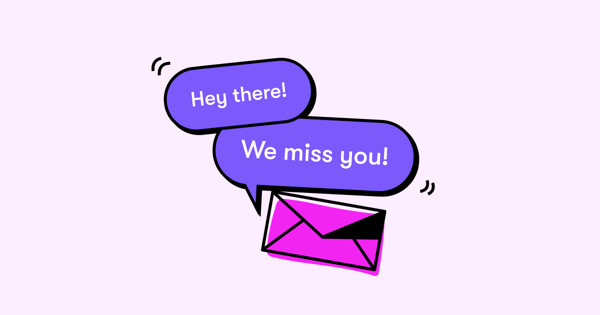You’ve built a long and stable relationship with a customer.
You understand their likes, dislikes, and buying patterns.
You celebrate their birthday, send them personalized product recommendations, and offer attractive discounts.
You know they follow you on social media, read your emails, and love your product. They’ve even left you a glowing review.
Then, suddenly, they vanish into thin air.
What gives?
It’s always disappointing when customers go cold on us. But all’s not lost, because there’s always a chance you’ll re-capture their interest with a well-timed and perfectly crafted winback campaign.
Everything You Need for a Stellar Winback Campaign:
What Is a Winback Campaign?
A winback campaign is an email series intended to re-engage lapsed subscribers who’ve stopped interacting with your marketing and/or buying your products.
As such, they’re sometimes referred to as re-engagement or reactivation campaigns.
The goal of all ecommerce winback campaigns is more or less the same: encouraging customers to open your emails, click through to your store, and buy something. But there are various ways to achieve it.
Some brands target lapsed email subscribers with unmissable offers; some remind customers of their mission, vision, and values; others simply ask why the subscriber in question stopped engaging.
Like so many things in the world of email marketing, there’s no such thing as a one-size-fits-all approach to winning back lost customers.
Rather, it’s about trialing a variety of strategies until you find what resonates best with your audience.
Why Are Winback Campaigns Important?
You might be thinking:
“We have thousands of people on our marketing list. Who cares if a few of them stop opening our emails?”
If only it were so simple.
By some estimates, inactive subscribers represent as much as 60 percent of the average email marketing list.
Or, to put it another way, if you have 50,000 names on your email list, only about 20,000 might be regularly engaging with your emails.
That’s a big problem, because it massively hurts your email marketing performance — particularly your open rate. If it goes on long enough? It can land your email in the spam folder too.
To be clear, this isn’t one of those vanity metrics that (some) marketers obsess over, but which has no actual impact on sales and revenue. A poor open rate has real consequences, sending a clear signal to email providers that people don’t particularly want to hear from you.
Given that those same providers pride themselves on shielding users from low-quality, spammy, unwelcome emails, this could end up hurting the deliverability of your future campaigns.
In the worst-case scenario, you might even be blocked from sending emails entirely.
With email marketing delivering an average return of $36 for every $1 spent, that’s a cost few ecommerce brands can afford to bear.
That’s where winback campaigns come in.
An old (but still interesting) study from MarTech discovered that winback campaign emails see an average 12 percent open rate.
Which isn’t particularly impressive. What is impressive is that 45 percent of people who receive a winback email go on to open subsequent messages from the brand in question.
So it seems that consumers take notice of winback campaign emails, even if they don’t actually engage with it.
That makes winback campaigns an invaluable tool for boosting open rates and ensuring your future emails end up in the main inbox.
How to Measure Success for a Winback Campaign
When assessing the performance of a customer winback campaign, it’s important to remember what you’re actually trying to achieve.
Your primary goal isn’t to achieve a sky-high open rate for your winback emails; it’s to deliver a sustained uptick in engagement for all of your email marketing activity.
Think of it this way:
You could send a winback email promising to give $10 to every customer who opens it.
But once they’ve cashed in on your generous offer, what incentive do they have to open future emails (other than the potential that you might give them another $10)?
For that reason, we recommend measuring winback campaign success by tracking changes in your open rate over time.
Take a benchmark figure — say, your average open rate over the past 12 months. Then see what happens in the month (or three months, or six months, or whatever makes most sense for your brand) after sending your winback campaign.
If your open rate goes up, your winback emails worked.
How to Segment Customers for Winback Campaigns
Lapsed customers aren’t a homogenous bunch.
Sure, it’d be easy to impose a blanket rule, like: “Every subscriber who hasn’t opened an email for 30 days is inactive.”
But in practice, the waters are a lot muddier than that.
For example, customer “A” — let’s call them Femi — might only open one email from you every three months, but immediately follow it up by placing an order.
Meanwhile, customer “B” (who I’m calling Jessie) might open every single one of your emails for a year, then ghost you for three weeks.
For my money, Jessie looks more like a lapsed customer than Femi, even though they’ve been “inactive” for a shorter period.
Confusing, huh?
When thinking about lapsed customers, it’s worth remembering they’re real people, not data points. They might include:
- Customers who were previously engaged with your messaging but appear at risk of lapsing.
- Repeat buyers who haven’t placed an order in a while.
- Previous high spenders who have suddenly stopped engaging with you.
- Totally disengaged subscribers who are beyond saving.
Clearly, you’re unlikely to succeed with a single, blanket attempt at winning back lost customers across all those categories. It might not even be worth your time trying to re-engage those in category #4.
That’s why it makes sense to apply a little RFM analysis to your winback campaign segmentation.
For the uninitiated, RFM stands for recency, frequency, and monetary.
In the context of winning back customers, that might refer to:
- Recency: The length of time since the customer last opened an email or made a purchase.
- Frequency: The number of orders they placed in a given timeframe.
- Monetary value: How much they spent in total or their average order value over the period in question.
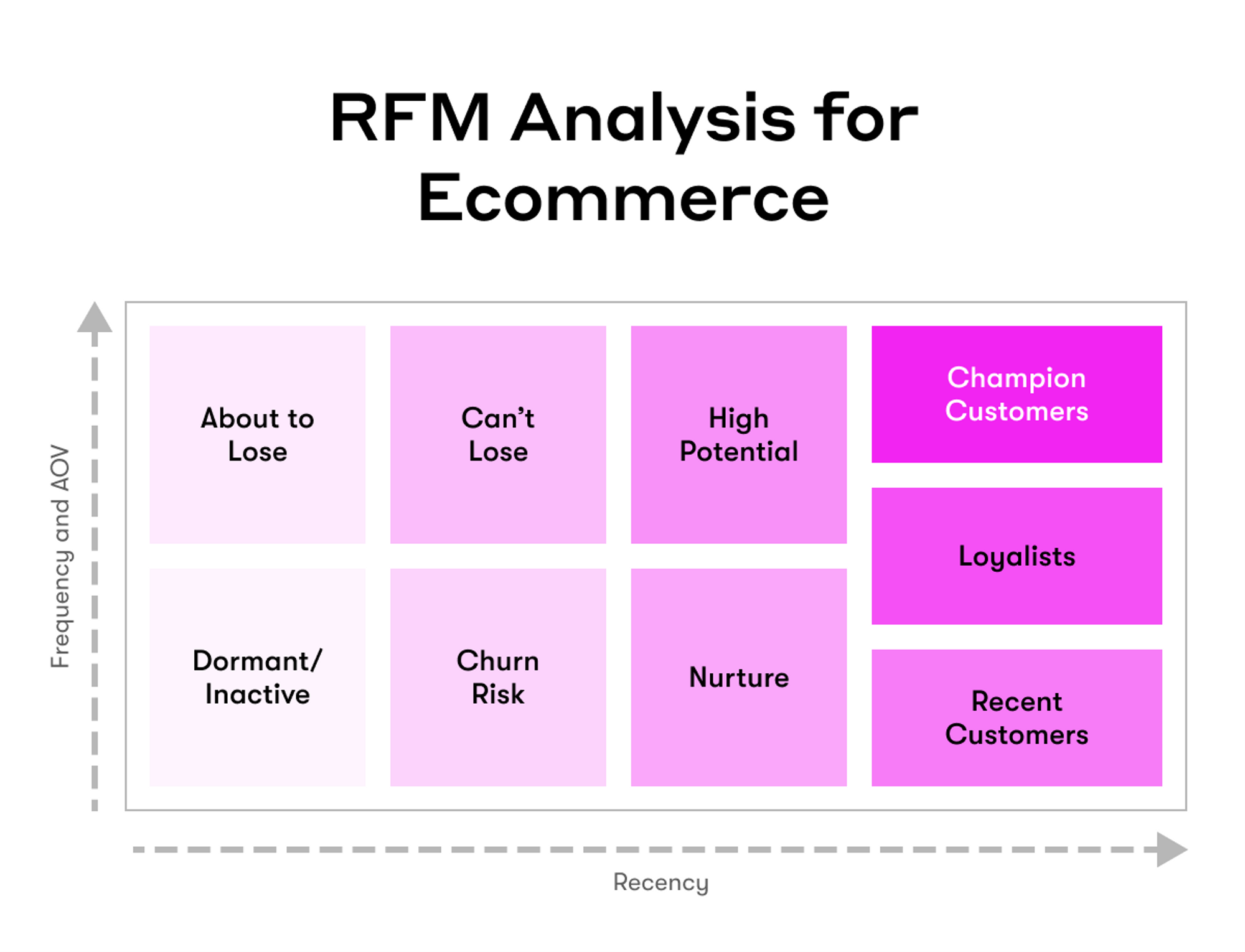
This approach makes it easier to identify high-value lapsed (and lapsing) customers, who are exactly the people you should be striving to retain.
You can segment these groups into priority winback campaigns featuring highly attractive offers, safe in the knowledge that if you succeed, you’re likely to recoup any short-term hit to your bottom line.
Slightly lower-value customers, meanwhile, might still be worth retaining — but not at any cost.
Tips for Building a Successful Winback Strategy
By re-engaging lapsed subscribers, an effective winback strategy can boost your customer lifetime value and increase your sales and revenue.
Follow these best practices to give your campaigns the best chance of success:
When to Send Winback Campaigns
Marketers send winback campaigns three months after customers stop engaging with the brand’s emails, on average.
Because if you leave it too long, you risk closing the stable door after the horse has bolted.
However, don’t treat three months as a blanket figure. The ideal timing depends on your audience, product, and business model.
For brands with high-ticket products and long sales cycles, it’s perfectly natural for customers to stop buying (or engaging with marketing emails) for months on end, before returning and making a big purchase.
Your best bet is to test different campaign timings to understand which approach works best for your brand and customers.
A/B Test Different Winback Promotions
Campaign timings aren’t the only thing you should test.
You should also trial multiple promotion types to figure out the offers most likely to resonate with lapsed (and lapsing) customers.
Again, different brands will get different answers here.
As much as I love my new Casper mattress, I’m definitely not going to buy a new one for several years, even if they send me a discount code. But if they offer me 10 percent off bedding or pillows… Well, maybe then I’ll sit up and listen.
Of course, in an ideal world, you won’t need to provide any kind of offer to re-engage lapsed customers.
Try testing various non-discount-related winback emails to see what cuts through.
(And if you need inspiration, check out the winback campaign examples later on in this article.)
What To Do if Customers Can’t Be Won Back
Every lapsed customer has lapsed for a reason.
Some of those reasons can be overcome with a simple reminder of why the customer signed up for your email list in the first place. Others might require an incentive to re-engage with your marketing.
But some customers simply can’t be won back. Their circumstances have changed, meaning they no longer have a need for your products. No amount of smart messaging or attractive promotions will win them round.
In that case, your best option is to tear off the band-aid and remove them from your email list, pronto.
Don’t treat this as a “loss.” Purging your marketing list of lapsed subscribers who never engage with your emails will improve your open rates, which helps your deliverability.
And anyway, who wants to waste time crafting beautiful, personalized emails for people who aren’t even listening?
24 Must-Open Winback Campaign Subject Lines
The higher your winback campaign open rate, the more customers you’re likely to re-engage.
And what’s the best way to increase your open rate? Writing a compelling, must-click email subject line.
According to OptinMonster, almost half of recipients decide whether to open emails based solely on the subject line. So the rewards for getting it right can be significant.
To help you out, I trawled through 250+ winback campaigns in Drip’s email swipe file to pick out the most impactful, innovative, and downright intriguing subject lines from ecommerce brands like yours.
We don’t recommend copy-pasting these examples straight into your next campaign — after all, you know your audience best. But feel free to use them for inspo…
Incentive-Based Winback Campaign Subject Lines
- We just gave you $10. Check it out! (ThirdLove)
- It's been a while, here's 20% off (Vrbo)
Customer Feedback-Based Winback Campaign Subject Lines
- Do you want to stay with us? (Boozt.com)
- how are you? (Recess)
- Just checking in (Ritual)
- Is it something we did? (Paperless Post)
Curiosity-Based Winback Campaign Subject Lines
- You’re going to want to open this (Bite)
- We don't want you to miss anything - Update your email settings (Mytheresa)
Last Chance Email Subject Lines
- Still there, Seray? (Torrid)
- We miss you {name} (Adidas)
- Where have you been? (Pura Vida Bracelets)
- Anyone there? (Joybird Furniture)
- Should we stay or should we go? (Decomposition)
- It's been a minute (ban.do)
- Can we make up? (Hygge Box)
- We miss you! (Buffy)
- It’s been a while (Warby Parker)
- Just a Reminder — We Miss You (Need Supply Co)
- We never talk anymore. (Tuft & Needle)
- We don't want to see you go! (Design Within Reach)
Breakup Email Subject Lines
- Too many emails? Let's change that! (Torrid)
- Our last email (Hygge Box)
- Removal from List, 1st Notice (The Spinsterz)
- Our last chance, to save this dying romance (Bellroy)
7 High-Converting Winback Campaign Examples You Can Steal
1. The Refresher Email
Before you start jumping to conclusions about all the negative opinions your subscribers might hold about your brand, consider that perhaps they just don’t know you well enough.
It’s completely possible that your brand or products seemed interesting enough in the beginning to sign up to your email list, but over time other things got in the way. Or maybe your product range didn’t catch their eye back then, and they haven’t had a chance to see all of your new and exciting additions.
Here’s where a little refresher can be helpful.
It’s an opportunity to remind your subscribers of exactly what your brand is all about, and what you have to offer right now. That could mean your USPs and brand message, or perhaps a showcase of your latest products and content, just like LastObject:
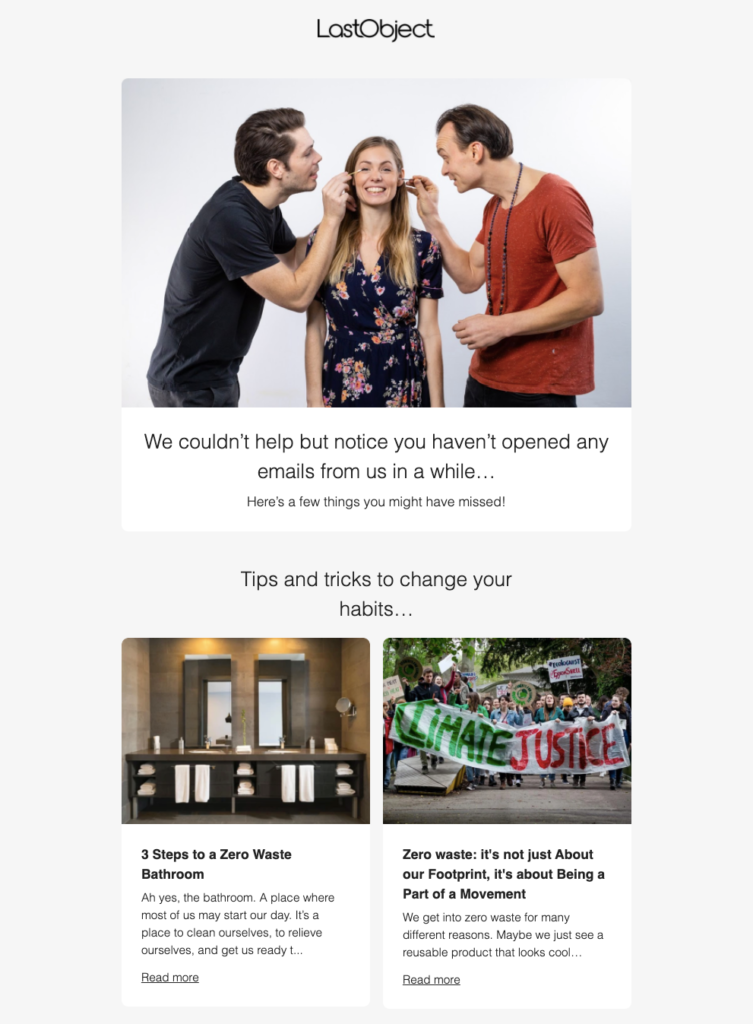 Right away, they get to the heart of the matter: you’ve been an inactive subscriber and you probably haven’t seen all the new things they’ve been up to.
Right away, they get to the heart of the matter: you’ve been an inactive subscriber and you probably haven’t seen all the new things they’ve been up to.
To start off with, there are two articles from their blog on how to lead a zero-waste, sustainable lifestyle. These immediately engage you with their core brand values of eco-friendliness, sustainability and activism, making it about more than just sales.
Next, they give you a taste of their expanding product range. LastObject is probably most well-known for its reusable LastSwab, which went viral on social media a while back, and so it’s likely that many of their subscribers are unaware of their new innovations. This email hopes to change that, with quick descriptions and CTAs to learn more.
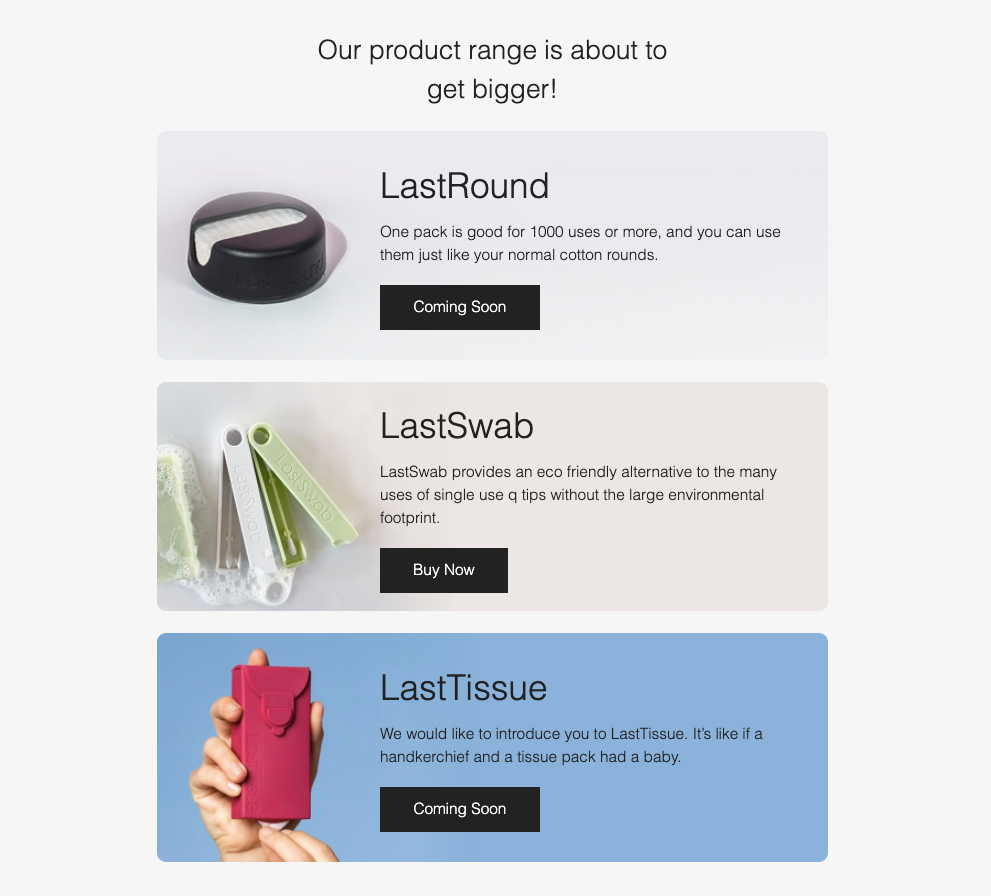 Refresher emails are a way to remind your subscribers why they joined your mailing list in the first place and keep your brand fresh in their mind, without the need for a discount or coupon.
Refresher emails are a way to remind your subscribers why they joined your mailing list in the first place and keep your brand fresh in their mind, without the need for a discount or coupon.
What they aren’t for is being overly salesy or aggressive. Like LastObject, it’s important that your email nudges rather than demands, with low-friction CTAs and engaging copy. It’s also important that you keep these kinds of emails up-to-date, so you can keep showcasing your latest ideas and improvements.
2. The Product Recommendation Email
One possible pain point for inactive subscribers is that your product catalog is simply too much to look through and there is just not enough time in the day. We’re all busy people, after all.
You can smooth out this wrinkle by going a step beyond and providing them with product recommendations, sorting through your product range to find things that will really appeal.
There are a myriad of ways to go about recommending products to subscribers, including seasonal gift guides or more personalized recommendations based on their recent browsing- or click-history.
Alternatively, you can think a little outside the box, as Asics does in this email:
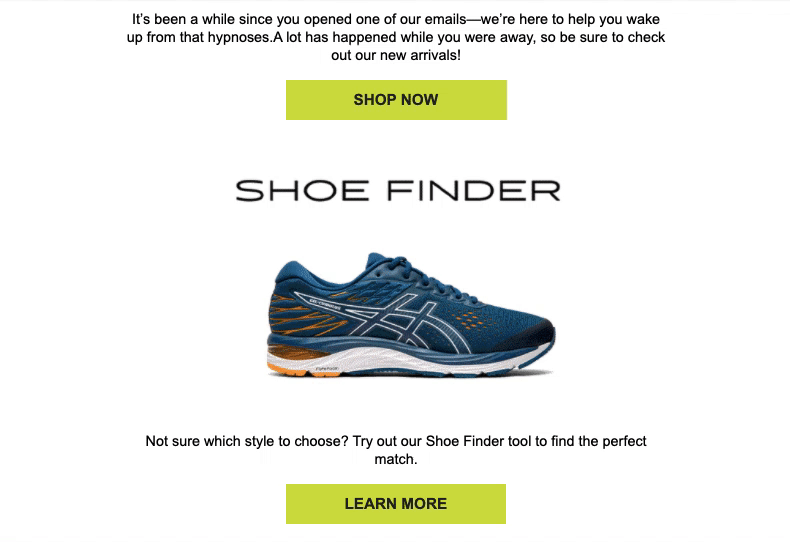 Finding which shoes are best for which activities can be difficult and a little overwhelming. That’s why Asics have developed a quiz that customers can use to find out exactly which shoes suit their needs best.
Finding which shoes are best for which activities can be difficult and a little overwhelming. That’s why Asics have developed a quiz that customers can use to find out exactly which shoes suit their needs best.
This way, they’re not overloading the email with shoes for different possible scenarios but putting the power into the hands of the subscriber.
By including this in their winback email, they’re acknowledging their subscribers’ problems and providing an easy solution, one that clears the road to make their journey to purchase easier and more efficient.
3. The Social Proof Email
Another potential reason that is stopping your subscribers from engaging with you is that hearing everything from you directly just isn’t enough. Of course, you know your brand better than anyone, but hearing good things from others is often the push people need to make a purchase.
Social proof is the idea that we have more faith in things that have been tried out and enjoyed by others, and it can be communicated in several ways. Think reviews, ratings, testimonials, endorsements, you name it.
Warby Parker, the online prescription glasses store, fill their email with tweets from satisfied customers:
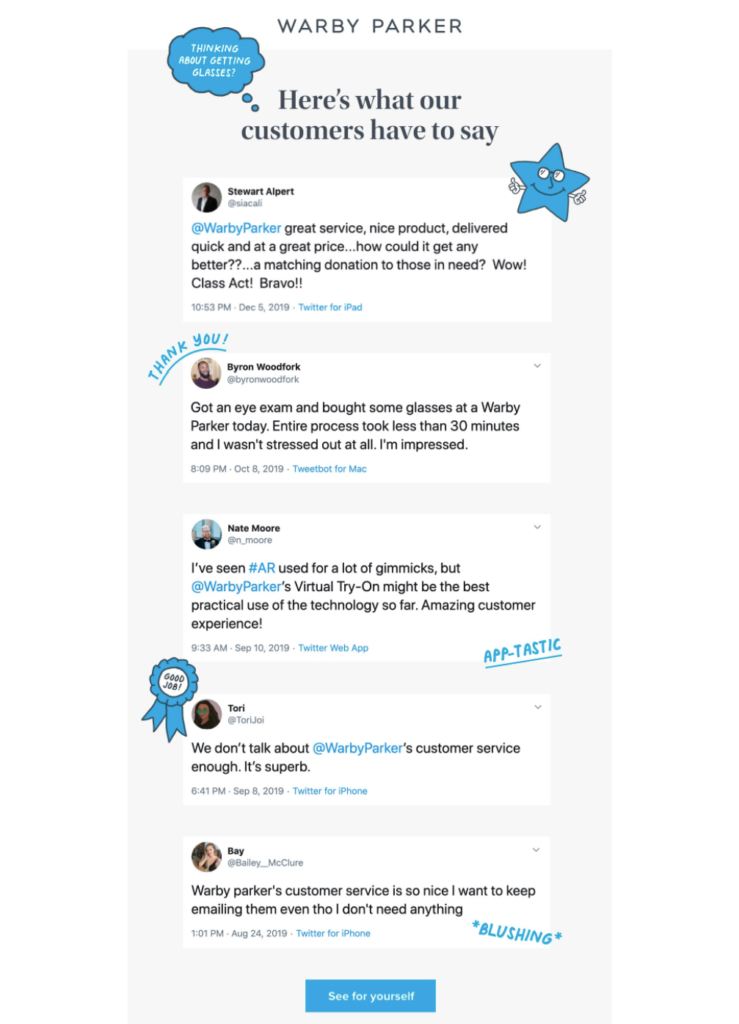 Competing against well-established high street brands comes with many challenges, and Warby Parker use these Twitter testimonials as social proof of their high-quality products and services that rival any competitors.
Competing against well-established high street brands comes with many challenges, and Warby Parker use these Twitter testimonials as social proof of their high-quality products and services that rival any competitors.
It would be one thing to list off these benefits themselves, but having their customers say it for them packs a much bigger punch. For a subscriber, learning that other customers think highly enough of a brand to write a tweet or leave a review may just tip the scales enough for them to open your emails and see what you’re all about.
4. The Incentive Email
Ah yes, the incentive email – the winback email that every brand thinks of and yet is reluctant to send out.
Why? Well, while discounts and coupons can be highly effective at re-engaging subscribers and customers, there are also times where they can do more harm than good. The trick is to know when to use them, and exactly what to offer.
Giving incentives to entice inactive subscribers back to the fold doesn’t have to be your first or only option, but adding the right kind to your winback email sequence can tempt back a price-conscious shopper.
The beauty product subscription service Birchbox added a percentage discount offer in their end-of-year winback email, which Seray recently received:
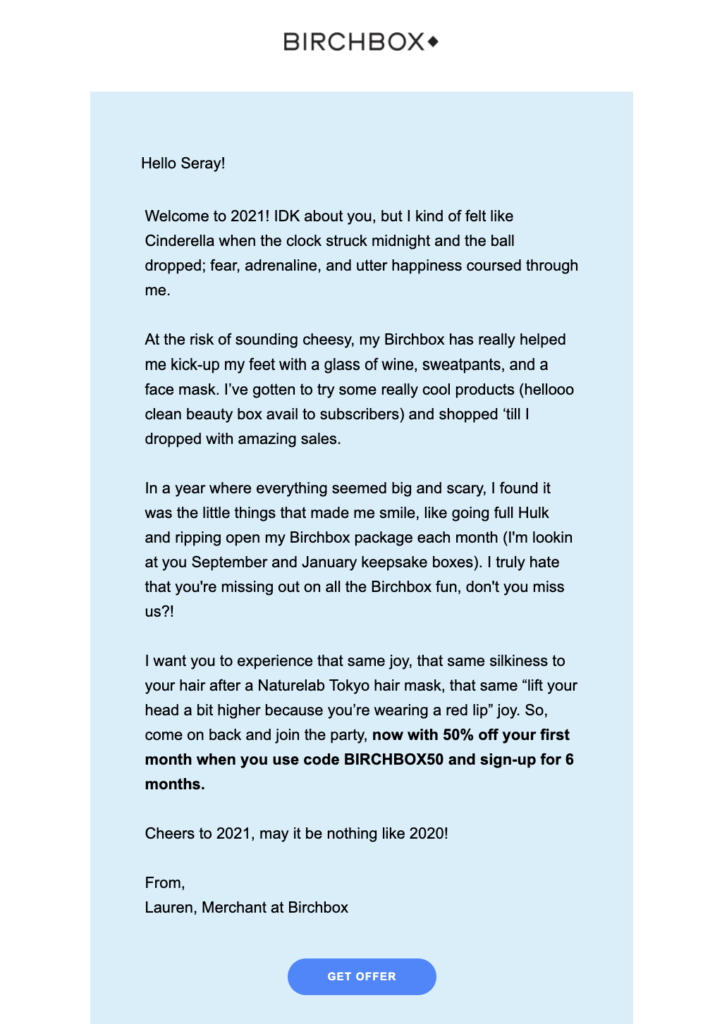 As well as using the new year as a way to persuade Seray to try out their service, they also offered her a coupon code for 50 percent off her first subscription box with a six-month sign-up, which sounds a pretty big deal.
As well as using the new year as a way to persuade Seray to try out their service, they also offered her a coupon code for 50 percent off her first subscription box with a six-month sign-up, which sounds a pretty big deal.
With its long but personal copy and the enclosed offer, this email may well have been an effective tactic for them. However, there are more ways to go about it.
Glossier, another beauty brand, takes a different approach. Instead of a discount, they offer a free gift alongside your purchase, and to make sure you know it, they put it right in the subject line:
 The email itself is very minimalistic—just a product image and a straightforward CTA, which fits well with their brand image:
The email itself is very minimalistic—just a product image and a straightforward CTA, which fits well with their brand image:
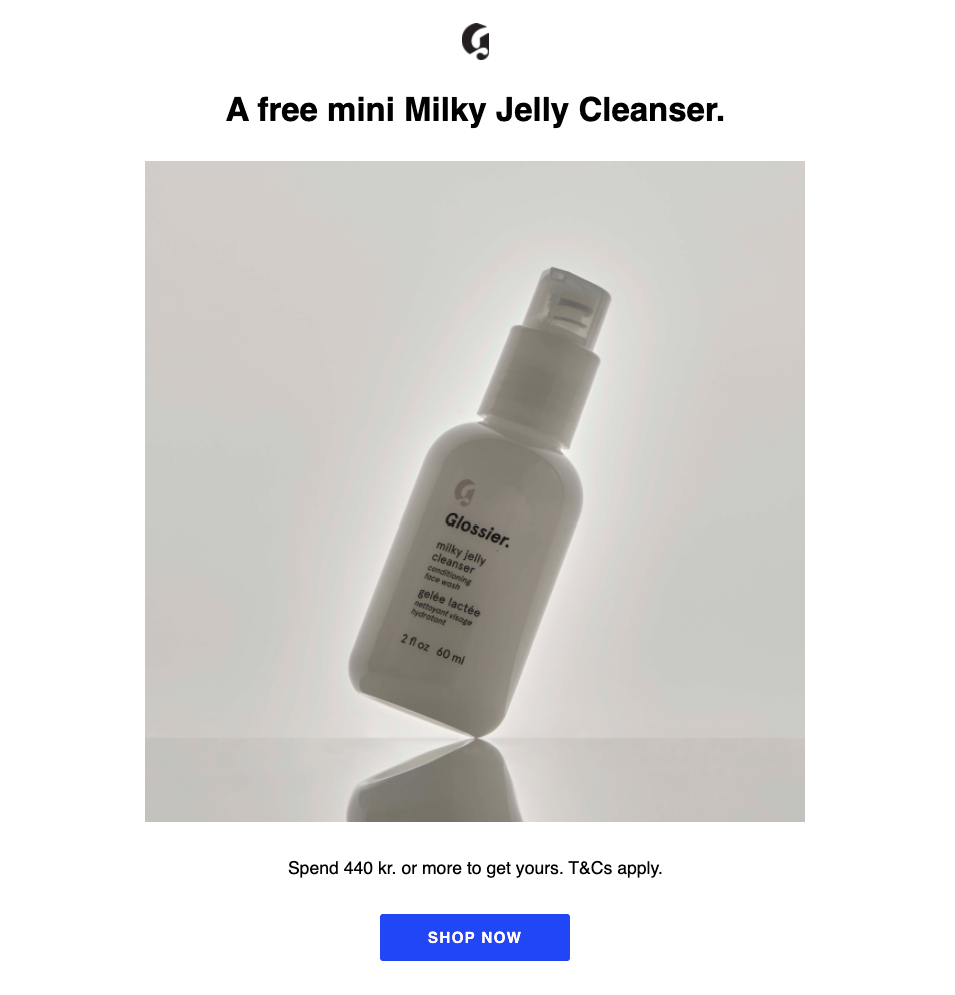 Product incentives have an advantage over traditional discounts in that they are more tangible. Receiving an extra item alongside your order can potentially build much more excitement than simply saving a little money.
Product incentives have an advantage over traditional discounts in that they are more tangible. Receiving an extra item alongside your order can potentially build much more excitement than simply saving a little money.
Other enticing incentives could include ‘dollar-amount’ discounts, which tend to perform better than percentage discounts, free shipping, extra loyalty program points, and sweepstakes. You could also try out incorporating limited-time offers into your winback emails, to add some urgency into the mix.
5. The Feedback Email
You can spend hours trying to work out why your subscribers aren’t engaging with your emails like you hoped, but doesn’t it make sense to ask them directly?
Feedback emails are commonplace for many other purposes, in marketing and beyond, and they are ideal for finding out exactly how to fine-tune your email strategy and re-engage your subscribers.
Take a look at this email from Proven for inspiration:
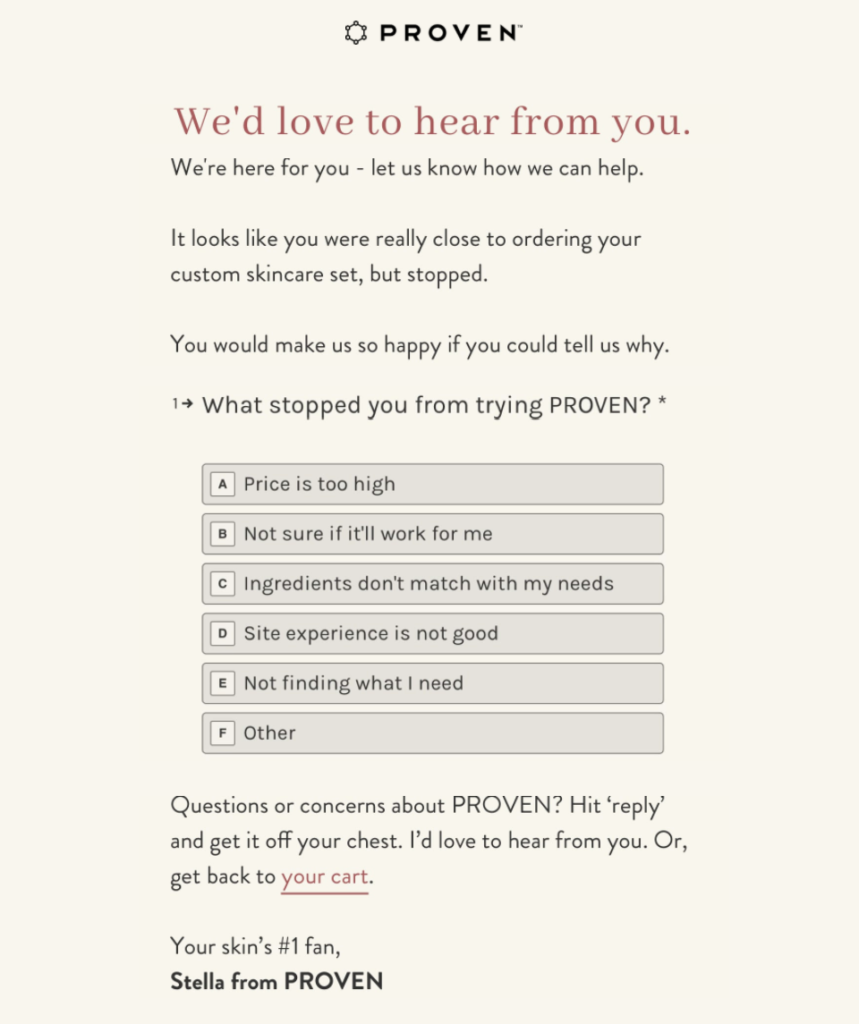 While this was sent as an abandoned cart email, it shares many qualities with what you think of as a winback email: a customer liked their brand, but something stopped them from fully engaging and completing a purchase.
While this was sent as an abandoned cart email, it shares many qualities with what you think of as a winback email: a customer liked their brand, but something stopped them from fully engaging and completing a purchase.
This email comes across as totally sincere, giving a number of legitimate reasons that may have stopped you from checking out. It also gives you them directly in the email, rather than providing a link to a survey in another tab.
This kind of email quickly makes subscribers feel heard and appreciated, especially when given the option to voice their questions or concerns directly to a human being. This feeling of being valued as a subscriber may be enough to start them engaging with your brand once more.
A winback email asking for feedback could also be easily combined with an incentive for filling out a form or survey, to encourage even the more disengaged subscriber to open the email and give their thoughts.
6. The Last Chance Email
Sometimes, the fear of losing something is a much more powerful motivator than the prospect of gaining something. In psychological terms, this is called loss aversion.
Here’s the scenario: your emails have been arriving in your subscriber’s inbox, only for them to look at them all and think ‘later’. This happens over and over again, until one day, an email arrives telling them that if they don’t click through, they’ll be unsubscribed in 30 days.
This is the last chance winback email, and its benefits are twofold.
Firstly, those who are afraid of losing your presence in their inbox will click to remain subscribed, and you have another chance to engage them with a catchy campaign. Second, if they do really want to end the relationship, then you clean your email list of an inactive subscriber.
This email from Tattly is a great example of how to formulate a last chance email:
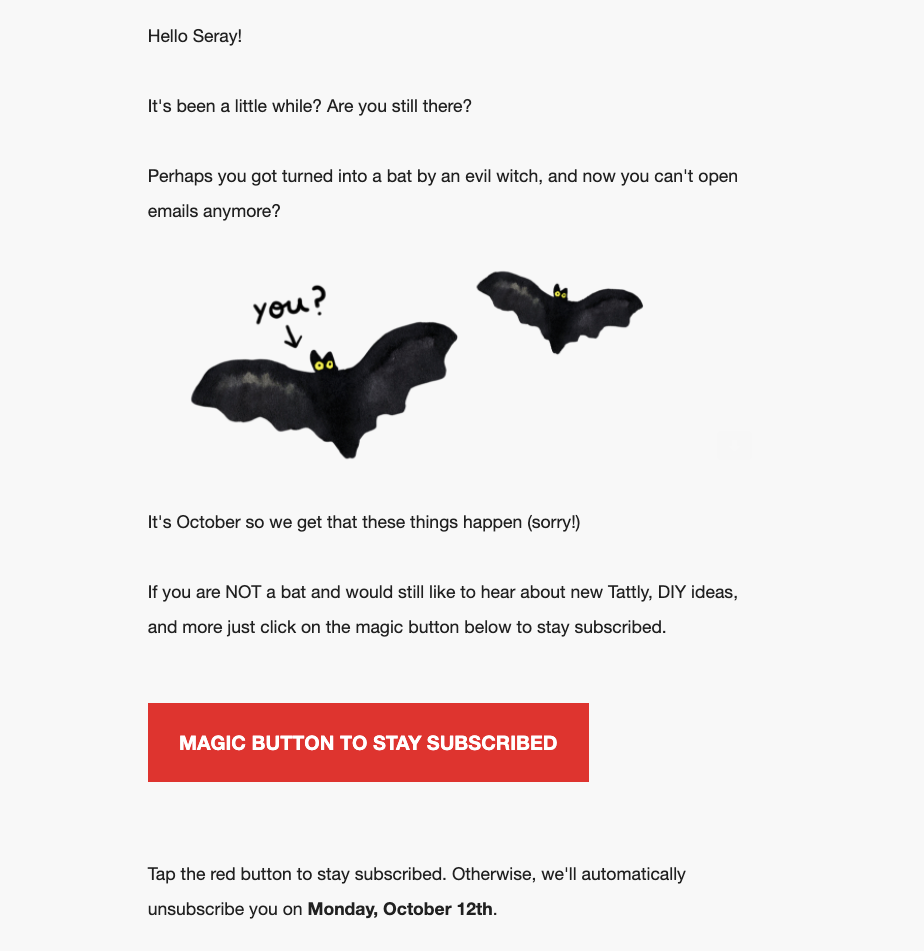 With a touch of humor and halloween spirit for the month of October, Tattly succinctly spells out the situation and what to do to fix it. It’s simple, easy to understand, and likable enough to encourage their subscribers to click that big red button.
With a touch of humor and halloween spirit for the month of October, Tattly succinctly spells out the situation and what to do to fix it. It’s simple, easy to understand, and likable enough to encourage their subscribers to click that big red button.
The most important aspect to get right in an email like this is to avoid guilt trips at all costs. Nothing makes a person switch off from a brand faster than being made to feel bad during their interactions. Keeping this message light leaves a door open for your subscribers to tune back in to your emails at a later, more convenient time.
Another way to leave the door open could be to include an option to receive fewer emails from you instead. Some of your subscribers may appreciate hearing about your new products every so often, but don’t want to be notified about every single sale you put on.
7. The Breakup Email
So you’ve sent your inactive subscribers a well thought out sequence of winback emails, attempting to entice them with everything from gift guides to customer reviews, even your latest blog content. But still no opens or click-throughs…
At this point, the kindest thing to do may be to let go. After all, if you love something, right?
Proactively removing inactive subscribers from your email list has several benefits, including reducing the number of people marking your emails as spam and increasing your lead quality and conversion rate.
I like the way that LastObject goes about it:
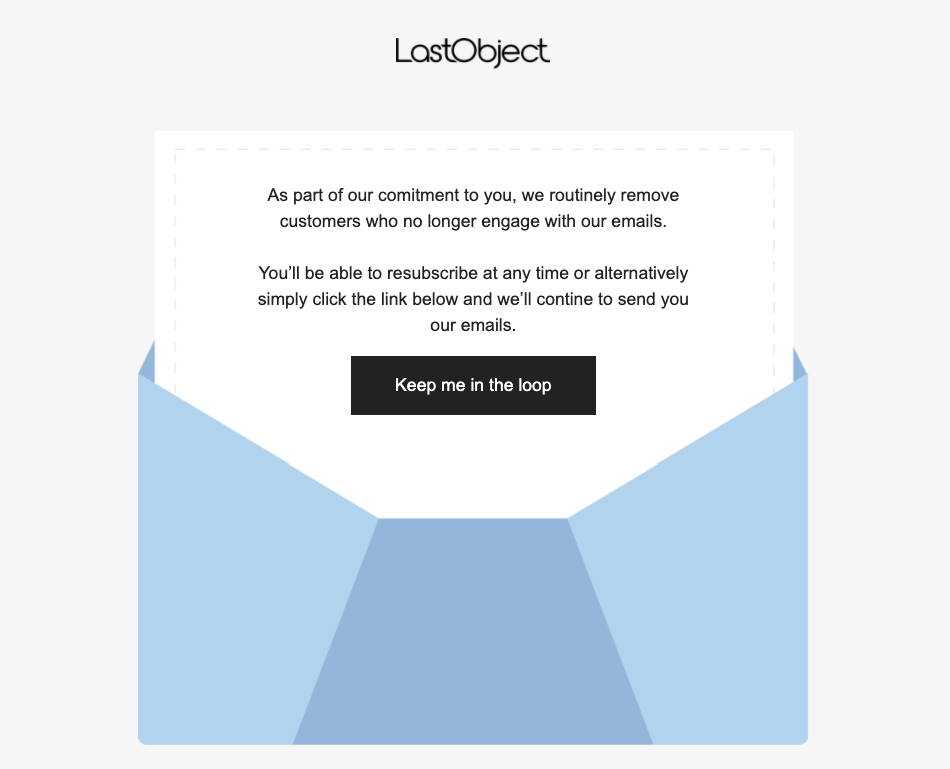 This email doesn’t take up any more time than it needs to. It’s short and to-the-point, yet the copy isn’t harsh or dismissive. They let you know why you’re being unsubscribed and that there’s no hard feelings involved.
This email doesn’t take up any more time than it needs to. It’s short and to-the-point, yet the copy isn’t harsh or dismissive. They let you know why you’re being unsubscribed and that there’s no hard feelings involved.
They also include that all-important CTA to resubscribe, just in case you get cold feet at the very last second, and mention that you can resubscribe later if that suits you better.
Showing a little empathy towards your subscribers and their overflowing inboxes can go a long way. It’s important to understand that they may not be in the place to read your emails or purchase from you right now, but that doesn’t mean the relationship is over forever.
There may well come a time when your brand is perfect for them, and leaving on a positive note could make all the difference.
Win Back More Lapsed Customers With Drip
A beautiful, well-written, persuasive winback email with a compelling subject line can grab the attention of lapsed customers and convince them you’re still the right brand for them.
But to send better winback emails, you need a tool that’s up to the task.
Drip is the platform you’ve been searching for.
We make it easy to create irresistible emails, letting you choose from 50+ professionally designed emails and customize every element to fit your brand and audience.
And you can test up to four email content variations or subject lines at a time to optimize your winback campaign performance.
Ready to find out more? Sign up for your 14-day free trial.
